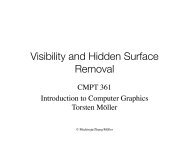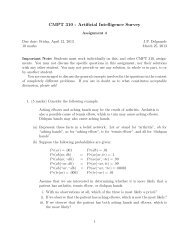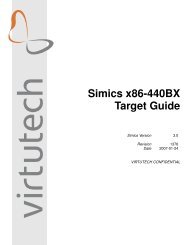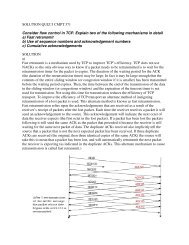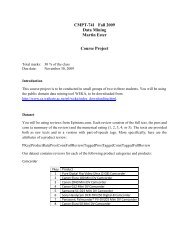Homework #2: CMPT-413
Homework #2: CMPT-413
Homework #2: CMPT-413
Create successful ePaper yourself
Turn your PDF publications into a flip-book with our unique Google optimized e-Paper software.
(3) † FST Recognition<br />
Implement the FST recognition algorithm. It should print True if the input pair of strings is accepted by<br />
the FST, and print False otherwise. You must use the fst module provided to you (assume that “from fst<br />
import fst” will load the module). The FST to use for this question is provided in the file<br />
fst example.py. Extend the FST class using inheritance so that you only need to add the recognize<br />
function. The file fst recognize stub.py shows how you can write a new class that inherits from the fst<br />
class. You have to implement the recognition algorithm rather than call the existing transduce function to<br />
infer the recognition output value.<br />
Your program should read the input and output strings for the FST from standard input, one per line. Your<br />
program should also show the steps of the recognize algorithm. Look at the testcases directory for<br />
examples of the output expected. The FST that is used for all test cases is the one defined in the<br />
fst example.py file.<br />
(4) Implement FST composition and add this functionality to your modified FST implementation defined in<br />
Q. 3. The two FSTs to be composed are provided in fst compose stub.py which also specifies the output.<br />
(5) † Minimum Edit Distance<br />
The following Python code computes the minimum number of edits: insertions, deletions, or substitutions<br />
that can convert an input source string to an input target string. Using the cost of 1, 1 and 2 for insertion,<br />
deletion and replacement is traditionally called Levenshtein distance.<br />
def distance(target, source, insertcost, deletecost, replacecost):<br />
n = len(target)+1<br />
m = len(source)+1<br />
# set up dist and initialize values<br />
dist = [ [0 for j in range(m)] for i in range(n) ]<br />
for i in range(1,n):<br />
dist[i][0] = dist[i-1][0] + insertcost<br />
for j in range(1,m):<br />
dist[0][j] = dist[0][j-1] + deletecost<br />
# align source and target strings<br />
for j in range(1,m):<br />
for i in range(1,n):<br />
inscost = insertcost + dist[i-1][j]<br />
delcost = deletecost + dist[i][j-1]<br />
if (source[j-1] == target[i-1]): add = 0<br />
else: add = replacecost<br />
substcost = add + dist[i-1][j-1]<br />
dist[i][j] = min(inscost, delcost, substcost)<br />
# return min edit distance<br />
return dist[n-1][m-1]<br />
if __name__=="__main__":<br />
from sys import argv<br />
if len(argv) > 2:<br />
print "levenshtein distance =", distance(argv[1], argv[2], 1, 1, 2)<br />
Let’s assume we save this program to the file distance.py, then:<br />
$ python2.5 distance.py gamble gumbo<br />
levenshtein distance = 5<br />
Your task is to produce the following visual display of the best (minimum distance) alignment:<br />
2



